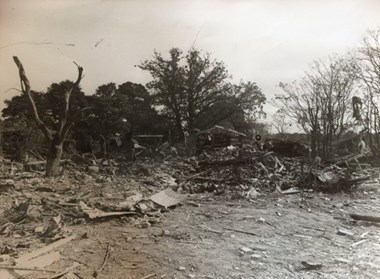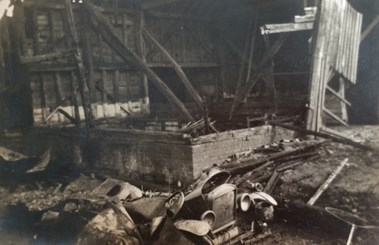Published on 08 May 2025
This 80th VE Day celebration marks a huge moment in history and it is a great opportunity to look back on the rich history of Benenden through the war.
Situated in the infamous Hellfire Corner in SE England, allied and enemy planes were a common sight over Benenden during the Second World War. Sadly, the village took several direct hits from the German V1 bombs, also known as ‘doodlebugs’.
Benenden Hospital
Benenden Hospital did not escape Hitler’s onslaught. The Hospital Administrator at the time, Mr Terence Barnett, said “The hospital suffered slightly when ten heavy explosive bombs fell near it in 1943 but it suffered much more as a result of enemy action on two occasions in 1944”.
On 17 June 1944 the Assistant Steward, his wife and daughter were killed by a doodlebug falling on their house on the hospital estate. Six patients and members of staff received injuries, one reported as serious.
On 4 August 1944 the nurses’ and domestic home wing, the catering department, dining room and the administration block were badly damaged by a bomb landing near the on-site Post Office. The crater it caused was later turned into a pond and rock garden.
The buildings were declared unsafe and the sanatorium was evacuated to temporary accommodation in Tunbridge Wells.


Benenden Village
Benenden had its own Home Guard Company who could regularly be seen on parade on the village green. This is an excerpt from a parish magazine article entitled “The Stand Down of the Home Guard” dated February 1945.
“While we all rejoice at the reasons which have permitted the authorities to pass the force on to a reserve basis, we shall miss the familiar figures in battledress about the village, to whom we have become so accustomed.
We have seen the Benenden Company grow from a gathering of men armed with shot guns, bottles and knives, whose only military insignia were a small percentage of badgeless army caps, worn somewhat sheepishly and in many cases at a very unmilitary angle, to a well-armed, well uniformed force of citizen soldiers.
It is not only for their military qualities that we shall remember: it will be some time before we forget the “Salute the Soldier Sports” on Church Field where they won the tug-of-war against three teams from the regular army.
We offer our congratulations to the members of the Company on the good job they have done and hope they will enjoy their new-found freedom.”
Capitaine Jean Maridor
In August 1944, a 23-year-old Free French Spitfire pilot with 91 Squadron RAF, Capitaine Jean Maridor, spotted a doodlebug over Rye. Despite repeated attempts to shoot it down, he was unable to ground it. At the time, Benenden Girls School had been converted to a casualty clearing station and had a large red cross on its roof. As it neared the School buildings, Capt. Maridor got within 50 metres of the bomb and managed to score a direct hit. Although the resulting explosion destroyed the bomb, it also tore off the Spitfire’s wing and sadly Capt. Maridor died when his plane crashed. His heroic actions saved not only the injured service men and women in the military hospital but also its doctors, nurses and Benenden villagers in the surrounding area.
There is a plaque in St George’s Church commemorating the bravery of Capt. Jean Maridor.
Share your own family memories from VE Day 1945 and your VE Day 80 celebrations with us through marketingbht@benenden.org.uk
SOURCES:
Benenden Hospital Heritage Project
Benenden – A Pictorial History (compiled by Michael Davies)
Benendenvillage.org.uk






